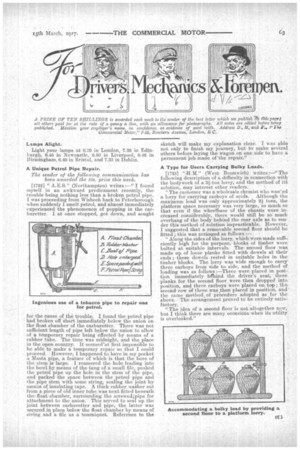Lamps Alight, Light your lamps at 6.69 in London, 7.26
Page 21

If you've noticed an error in this article please click here to report it so we can fix it.
in Edinburgh, 6.45 in Newcastle, 6.50 in Liverpool, 6.46 in Birmingham, 6.49 in Bristol, and 7.33 in Dublin.
A Unique Petrol Pipe Repair.
The sender of the following eolnmunication has been awarded the 108. prize this iveelc.
[17221 " A.E.S." (Northampton) writes :—" I found myself in an awkward predicament recently, the trouble being nothing less than a broken petrol pipe. I was proceeding from Wisbech back to Peterborough when suddenly I smelt petrol, and almost immediately experienced the phenomenon of popping in the carburetter. I at once stopped, got down, and sought for the cause of the trouble. I found the petrol pipe had broken off short immediately below the union on the float chamber of the carburetter. There was not sufficient length of pipe left below the union to allow of a temporary repair being effected by means of a rubber tube. The time was midnight, and the place in the open country. It seemed'at first impossible to be able to make a temporary repair so that I could proceed. However, I happened to have in my pocket a Masta pipe, a feature of which is that the bore of the stem IS large. I reamered the hole leading into the bowl by means of the tang of a small file, pushed the petrol pipe up the hole in the stem of the pipe, and nacked• the space between the petrol pipe and the pipe stem with some string, sealing the joint by means of insulating tape. A thick rubber washer cut from a piece of old inner tube was next fitted beneath the,float. chamber, surrounding the screwedipipe for attachment to the union. This served to seal up the joint between carburetter and pipe, the latter was secured in place below the float chamber by means of string and a file as a tourniquet. Reference to the
sketch will make my explanation clear. I was able not only to finish my journey, but to make several others before laying the wagon on one side to have a; permanent job made orthe repair."
A Type for Users Carrying Bulky Loads.
[1723] "H.M." (West Bromwich) writes :—" The following description of a difficulty in connection with the bodywork of a 31-ton lorry, and the method of it solution, may interest other readers. "The customer was a wholesale chemist who wanted a lorry for carrying carboys of acids. Although. the maximum load was only approximately 2i tons, the platform space necessary was very large, so much so that even if the wheelbase of the chassis were increased considerably, there would still be so much overhang of the body behind the rear axle as to render this method of solution impracticable. However, I suggested that a removable second floor should be fitted; this was arranged as follows :— "Along the sides of the lorry, which were made sufficiently high for the purpose, blocks of timber were bolted at suitable intervals. The second floor was made up of loose planks fitted with -dowels at their ends ;these dowels rested in suitable holes in the timber blocks. The lorry was wide enough to carry three carboys from side to side, and the method of loading was as follows :—Three were placed in position immediately behind the driver's seat, three .planks for the second floor were then dropped into position, and three carboys were placed on tog; the second row o-F three was.then placed in position, and the same method, of procedure adopted as for the above. The arrangement proved to be entirely satisfactory.
"The idea of a second floor is not altogether new,. but I think there are many occasions when its utility is overlooked."






















